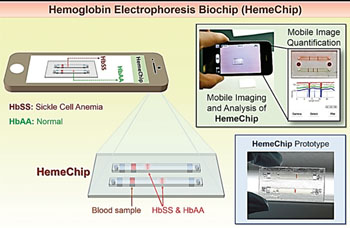New Technology Standardizes Screening for Sickle Cell Disease
By LabMedica International staff writers
Posted on 23 Dec 2015
Over half of babies born with sickle cell disease (SCD) in countries with limited resources die before age five and over six million people in West and Central Africa suffer from the disease, which causes pain crises, widespread organ damage and early mortality. Posted on 23 Dec 2015
Newborn screening tests can only be performed in central laboratories in developing countries and the results can take several weeks and it may be impossible to reach the parents after they have left the health center. This may delay the onset of important interventions, including immunizations, antibiotics and vitamins and therefore, there is a need for simple, rapid and mobile analyses of hemoglobin types in newborn blood.

Image: The HemeChip micro-electrophoretic device that examines and identifies hemoglobins including hemoglobinopathies (Photo courtesy of Case Western Reserve University).
Scientists at Case Western Reserve University School of Medicine (Cleveland, OH, USA) have developed an innovative mobile device, the Hemoglobin-Electrophoresis Biochip or HemeChip, which has the unique ability to rapidly screen for sickle cell disease with just a few drops of blood. They utilized a micro-engineered design and microfluidic approach in HemeChip development. Microfluidic technology is a novel tool which allows small sample volume of less than 20 µL of blood, from a finger or heel prick. Other attributes of the HemeChip are portability, ease of use, and low power consumption.
The HemeChip, a micro-electrophoretic device, examines and identifies hemoglobins, including hemoglobinopathies sickle cell anemia (HbSS), sickle trait (HbAS) and SC disease (HbSC). The microchip system allows rapid manual assembly and is single use, to prevent potential cross-contamination between patients. HemeChip fabrication is suitable for mass-production, which is critical for translation of point-of-care technologies. At present, the HemeChip material cost is less than USD 5.00, and this cost is likely to decrease if mass-produced.
Jane Little, MD, an associate professor and lead author of the study, said, “While sickle cell newborn screening is standard in the USA, very few infants are screened in Africa because of the high cost and level of skill needed to run traditional tests. This new mobile technology provides an easy to use, cost-effective tool that takes us closer to standardizing newborn screenings on mobile devices, thus simplifying diagnosis. It could make a huge difference in developing nations worldwide, enabling early treatment for this disease.” The study was presented at the 57th Annual Meeting of the American Society of Hematology (ASH) held December 5–8, 2015, in Orlando (FL, USA).
Related Links:
Case Western Reserve University School of Medicine














